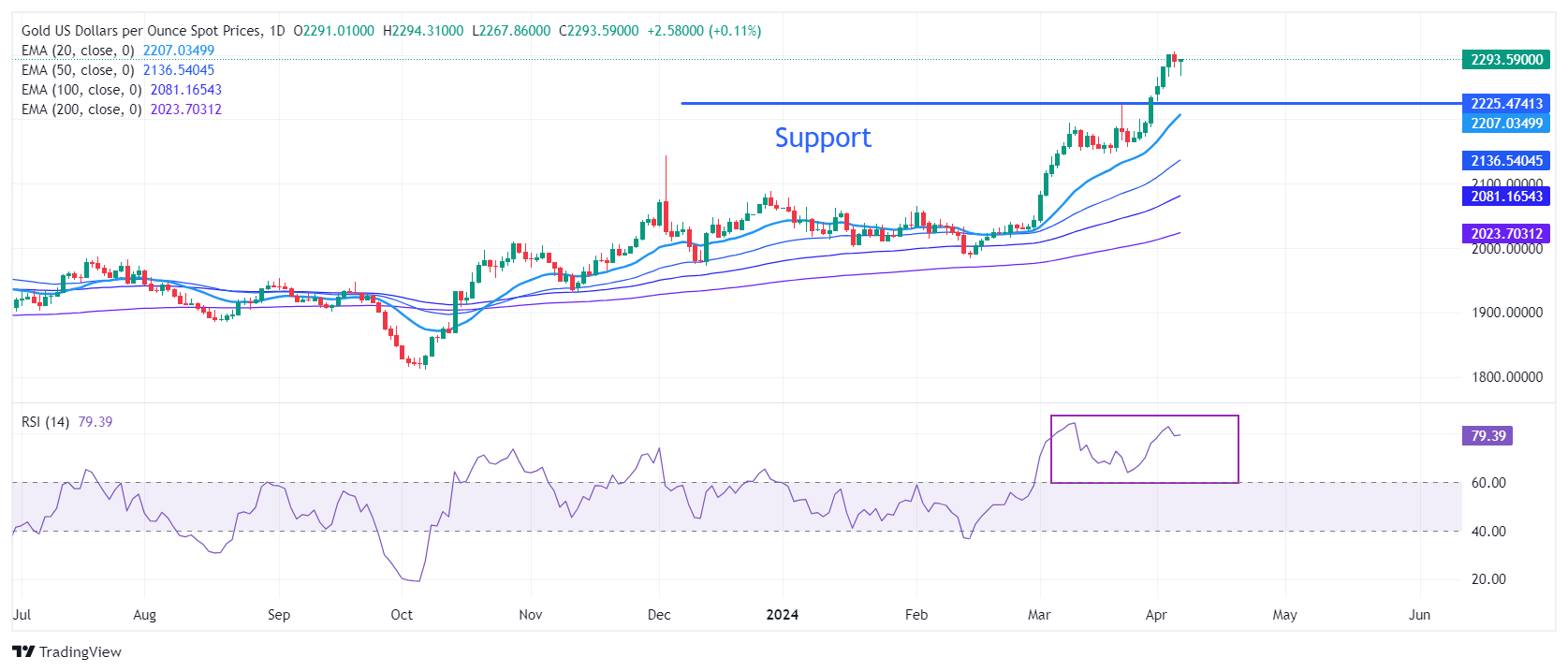- Gold price is pressured by surprising US NFP data.
- The US dollar rises as Fed Chairman Kashkari has stated that he does not foresee rate cuts if inflation remains persistent.
- Escalating tensions in the Middle East keep safe haven offers strong.
The price of Gold (XAU/USD) falls in the early hours of the US Friday session, as the US Bureau of Labor Statistics (BLS) has reported that labor market conditions have strengthened even more so in March. The Nonfarm Payrolls (NFP) report has shown that hiring remained robust, while average annual hourly earnings slowed as expected. US employers added 303,000 jobs, significantly above expectations of 200,000 and the previous reading of 270,000, revised slightly downward from 275,000. The unemployment rate falls to 3.8%, compared to the consensus and the previous reading of 3.9%.
As expected, annual wage growth rose 4.1%, slower than the previous reading of 4.3%. Monthly average hourly earnings also grew at the expected pace of 0.3%, remaining above February's reading of 0.2%, revised up from 0.1%.
Strong demand for labor is expected to slow inflation's progress toward 2%, which could negatively influence market expectations that the Federal Reserve (Fed) will begin reducing interest rates in June. This will increase the opportunity cost of maintaining an investment in non-performing assets, such as Gold, weighing down its price. The 10-year US Treasury yield jumps to 4.39% as strong labor market conditions will allow the Fed to keep interest rates higher for longer.
Currently, CME's FedWatch tool shows that traders are pricing in a 58% chance that the Fed will cut interest rates in June. Traders' bets on a Fed rate cut fall after upbeat US NFP data.
The US Dollar Index (DXY), which measures the value of the greenback against six major currencies, extends its recovery to 104.50 as strong employment conditions indicate an optimistic economic outlook.
This week, the US Dollar faced a sharp sell-off after the US Services PMI for March came out weak. The services PMI fell to 51.4 in March, versus expectations of 52.7, and the previous reading was 52.6.
Daily summary of market movements: Gold price falls after solid hiring data
- Gold takes a pause after a strong rise to $2,300 as the US NFP report for March indicates strong demand for labor. Expectations that the Federal Reserve will move to cut interest rates have fallen, as good labor market conditions will not force Fed officials to rush to reduce interest rates sooner than expected.
- Average hourly earnings remain uneven. Annual figures slowed as expected, while monthly data grew in line with expectations. Looking ahead, strong demand for labor would drive wage growth higher. Employers offer higher wages to compensate for the strong demand for workers.
- On Thursday, Minneapolis Fed President Neel Kashkari said rate cuts will not be necessary this year if inflation stagnates. Kashkari said he forecast two rate cuts by 2024 in the Fed's latest dot chart. “The Fed needs to keep interest rates higher in the 5.25%-5.50% range if inflation remains stronger than expected.” “Kashkari warned. He added that if that didn't work, further rate hikes are not ruled out, but they are also not a likely scenario given what we know right now,” Reuters reports.
- Meanwhile, Gold's short-term appeal remains strong due to escalating tensions in the Middle East. Airstrikes by Israeli forces against the Iranian embassy in Damascus, located near the Syrian capital, have heightened fears of Iran's involvement in the war between Israel and Palestine. The increase in geopolitical tensions drives investors towards safe haven assets such as Gold.
Technical analysis: Gold price retreats from all-time highs of $2,300

The price of Gold falls slightly after reaching the $2,300 level. Short-term demand remains intact as all short-term to long-term exponential moving averages (EMAs) are tilted upwards. On the downside, the March 21 high at $2,223 will be an important support zone for gold price bulls.
The 14-period Relative Strength Index (RSI) near 80.00 indicates that the bullish momentum remains active. However, signs of overbought have emerged.
Nonfarm Payrolls FAQ
What are non-farm payrolls?
Nonfarm payrolls (NFP) are part of the monthly employment report from the US Bureau of Labor Statistics. The nonfarm payrolls component specifically measures the change in the number of people employed in the US during the previous month, excluding the agricultural sector.
How do nonfarm payrolls influence the Federal Reserve's monetary policy decisions?
The nonfarm payrolls figure can influence Federal Reserve decisions by providing a measure of how successfully the Fed is fulfilling its mandate of promoting full employment and 2% inflation.
A relatively high nonfarm payroll figure means that more people are employed, earning more money, and therefore likely spending more. Conversely, a relatively low nonfarm payrolls result could mean that people have difficulty finding work.
The Federal Reserve typically raises interest rates to combat high inflation caused by low unemployment, and lowers them to stimulate a stagnant labor market.
How do non-farm payrolls affect the US dollar?
Non-farm payrolls typically have a positive correlation with the US Dollar. This means that when payroll numbers are higher than expected, the Dollar tends to rise and vice versa when they are lower.
The NFP influences the US Dollar through its impact on inflation, monetary policy expectations, and interest rates. A higher NFP usually means that the Federal Reserve will be tighter in its monetary policy, which supports the USD.
How do non-farm payrolls affect the price of Gold?
Non-farm payrolls usually have a negative correlation with the price of Gold. This means that a higher than expected payroll figure will have a depressive effect on the price of Gold and vice versa.
A higher NFP usually has a positive effect on the value of the USD, and like most major commodities, Gold is priced in US Dollars. Therefore, if the USD gains value, fewer Dollars are needed to buy an ounce of Gold.
Furthermore, higher interest rates (usually aided by a higher NFP) also reduce the attractiveness of Gold as an investment compared to staying in cash, where the money will at least earn interest.
Sometimes nonfarm payrolls provoke a reaction opposite to what the market expects. For what is this?
Nonfarm payrolls are just one component within a larger employment report and can be overshadowed by the other components.
Sometimes, when nonfarm payrolls beat forecasts but average weekly earnings are lower than expected, the market has ignored the potentially inflationary effect of the headline result and interpreted the drop in earnings as deflationary.
The Participation Rate and Average Weekly Hours components can also influence the market reaction, but only on rare occasions, such as in the “Great Resignation” or the Global Financial Crisis.
Source: Fx Street
I am Joshua Winder, a senior-level journalist and editor at World Stock Market. I specialize in covering news related to the stock market and economic trends. With more than 8 years of experience in this field, I have become an expert in financial reporting.







